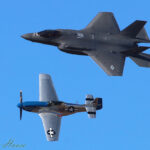By Stephen Chapis
Today’s 4th Fighter Wing (FW) is one of two U.S. Air Force units that traces its history back to a foreign country. Making their combat debut on February 5, 1941, nearly a full year before the more lauded Flying Tigers, the Eagle Squadrons (Nos 71, 121, and 133 Squadrons) of the Royal Air Force consisted of Hurricanes and Spitfires flown by American pilots. From the time the Eagle Squadrons were inducted into the USAAF as the 4th Fighter Group on September 29, 1942, the wing’s combat legacy spans five wars and six decades. From destroying over 1,500 enemy aircraft and producing 106 aces, including America’s first jet ace, in World War II and Korea to Vietnam and Syria, the wing’s projection of American combat airpower is unparalleled and has more than lived up to its motto “Fourth But First”.
When warbird operators restore a fighter, they will often choose to paint the aircraft to represent the aircraft flown by a famous ace if applicable. Such was not the case when RT Dickson chose the scheme for his F-86 project. Vintage Aviation News founder Moreno Aguiari interviewed RT about his chosen paint scheme a week before it was revealed to the public.
RT’s warbird flying began with a T-35 Buckaroo that his father acquired in 1974. RT said, “I grew up with that airplane in the basement of the house. That kind of sent me on the path to warbirds.” After years of logging tailwheel time in a Super Cub and the Buckaroo, RT went straight to the Mustang when he acquired Swamp Fox. Through showing this Mustang at various airshows, RT met many warbird personalities, including Steve Hinton, who is a well-known proponent of the Sabre, and advised RT that he would enjoy adding a Sabre to his hangar.
It took time, but several years later RT became aware of an off-market Sabre through a friend. In July 2021, RT was joined by Steve Hinton of Fighter Rebuilders/Planes of Fame and Matt Nightingale of on a trip to Mojave to perform the pre-buy. Once RT decided to purchase the jet, he placed it in the care of Nightingale’s shop with Hinton consulting on the restoration. The next big decision was nearly as important as the decision to purchase and one that everyone takes a keen interest in: the paint scheme. Among the ten or so flying F-86s, most are finished as Korean War-era Sabres of the 4th and 51st FIW, many of which represent aces. Would RT follow the trend? Well, yes and no.
Among the 41 Sabre aces to come out of the Korean War, 7-victory ace Capt. Clifford D. Jolley of the 4th FIW/334th FIS is notable. He was the first and only ace from the Air National Guard (Utah) and received a Silver Star for gallantry during an engagement on July 4, 1952. It was Jolley’s aircraft, F-86E-10 USAF #51-2834 that RT decided to depict, but not as flown by Jolley himself.
“We wanted to do something that had never been done before on an F-86. Everybody loves a famous paint scheme except they’re often replicated multiple times. In fact, Jolley’s Sabre has been done by Planes of Fame, but they don’t have the Jolly Roger flag painted on the side. Since his last name was Jolley, he painted the skull and crossbones flag on the fuselage. It’s a very famous paint scheme and very cool with that large pirate flag. When Captain Jolley rotated home, his jet was transferred from the Chiefs [334th FIS] to the 336th Fabulous Rocketeers.” RT explained.
When ‘834 arrived at its new squadron, it was assigned to Capt. Joseph C. Romack chose to retain the pirate flag but changed the name to Patricia II after his then-girlfriend.
Romack was not an ace, but he did score a pair of aerial victories. RT went on to explain why he chose this particular scheme, “Romack had a very interesting background. When he left Korea, he went to the test pilot school and was one of the first 110 candidates in the astronaut program. I also like the scheme because he’s kinda like me, he flew P-51s, and then he got into the Sabre. I’m flying a P-51 and will soon be in a Sabre.” Dickson closed by saying the jet is expected to fly soon and he is currently lining up airshows for mid-2024.
































